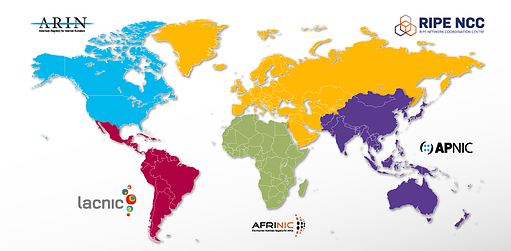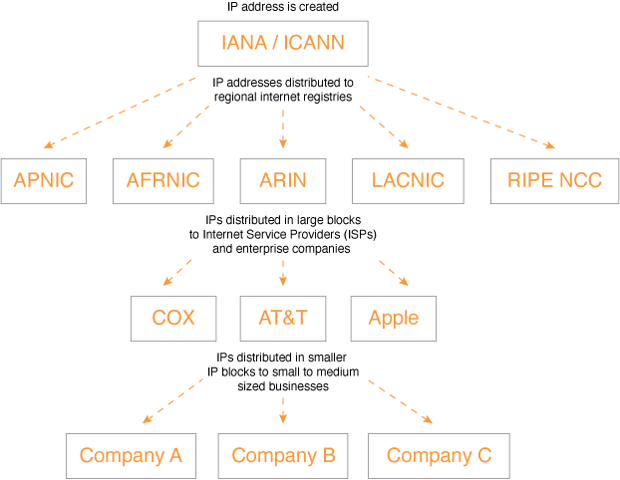The concept of an IP address is pretty simple: a unique combination of numbers and sometimes letters that identifies an internet-connected device. However, behind an IP address lies an entire world of registries, databases, and valuable information marketers can use to power their account-based marketing strategies. That is if they know where to look.
To understand the industry of IP address data, we first must understand where IP data comes from.
How IP addresses are created:
Believe it or not, these addresses are not just randomly assigned to your internet devices when you purchase them. They vary depending on the type and age of the device you’re using and can even change over time.
IP addresses start their life at Internet Corporation for Assigned Names and Numbers (ICANN). This non-profit organization helps maintain the security and usability of the internet. A division of ICANN called the Internet Assigned Numbers Authority (IANA) mathematically produces and allocates all the IP addresses in existence. Think of ICANN and IANA as the factory for IP addresses – they create them and determine where they go.
Once IP addresses are created, the IANA assigns blocks of IP addresses to Regional Internet Registries (RIRs), which are in charge of allocating and registering IP addresses throughout various world regions.
 Source: ripe.net
Source: ripe.net
These registries then lease out large blocks of IP addresses to large companies and Internet Service Providers (ISPs), who in turn lease smaller IP blocks out to businesses and individual consumers through their devices.

Now that we know how internet registries work let’s look at how B2B marketers can gather company information from an IP address.
Public Data Sources: This is what you might know as a “reverse IP” lookup. These websites allow you to copy/paste an IP address into their platform, and they give you the company data stored on the Regional Internet Registry.
The benefit of using public IP address data is that it is generally free to access, with thousands of websites allowing you to copy/paste IP addresses one by one and see what’s in the public record. However, the information stored in public registries is reported by the ISP companies to have no incentive or penalty programs in place to ensure they actually follow through and report their company data to the public registries correctly. This leads to numerous mistakes in the public record with many IP addresses that actually belong to companies with no public record, inaccurate data, or outdated records.
Looking at the journey of an IP address from creation to end-user (or company) it’s important to note that large companies like Apple, Microsoft, Cisco, etc. are large enough to lease out their own blocks of IP addresses directly from the Regional Internet Registries. This makes these companies generally easy to identify and we can generally assume their information has been accurately reported in the public record.
However, the problem marketers face when trying to extract value from public IP registries is that most analytics platforms do not allow you to access the IP addresses of your website visitors. In addition, most analytics and marketing automation platforms rely on public registry data to identify website visitors and fail to provide any actionable information for B2B marketers.
Finally, most, if not all, public reverse IP lookup sites only allow users to copy/paste one IP address at a time. This wouldn’t be a big deal if you’re only looking up a handful of IPs, but your website likely gets many more visitors than that per day. Even if you somehow were able to gather the IP addresses of all your visitors, copy and pasting hundreds of them per day into one of these websites would get real old real fast and provide little to no value.
Private Data Sources: These are companies, like KickFire, that can detect the IP addresses of website visitors and analyze them using proprietary methods to find the company data hidden behind the ISP and provide real value to B2B marketers. Private data often requires an investment but is much more robust, accurate, and up-to-date than the data stored in a public record.
Private data companies devote massive amounts of time and money to building and maintaining their IP address databases and are constantly in competition with one another to provide the best and most accurate data. Research done by KickFire has estimated private data sources have a roughly 520% increase in company identification compared to public data sources.
Not only do private data sources give you better firmographic information than public data sources do, but they also provide a vast amount of additional information that can be used to enhance sales and marketing efforts. Another benefit of using a private IP data source is that you, as the marketer, can access all the valuable company information about your website visitors without lifting a finger. Technologies like KickFire, work through a tag that lives on your website, constantly monitoring and reporting information about the companies that visit.
| Public Sources: | Private Sources: | ||
| Company Name | Company Name | Website | NAICS Description |
| Visitor Location | Visitor Location | City | NAICS Code |
| Visitor City Postal Code | Company Postal Code | Telephone Number | Latitude/Longitude |
| Visitor City Latitude/Longitude | Company Address | Employee Count | Stock Symbol |
| Region Abbr. | Region Abbr. | Revenue | Social Media URLs |
| Region | Region | SIC Group | ISP/WiFi Filter |
| Country Abbr. | Country Abbr. | SIC Description | Confidence Score |
| Country | Country | SIC Code | Trade Name |
What can you do with IP intelligence data?
Content Personalization: Data like this can be used to personalize content across your website like welcome banners, images, copy, navigation, and more. In addition, you can tailor your messaging for each specific audience to better resonate with your visitors.
ICP Targeting: Your Ideal Customer Profile (ICP) is the type of customer you want to sell to – the type of customer that brings the most value to your organization and gets the most value from your products in return. An easy way to determine what companies might be your ideal customers is looking at the companies that are viewing a high number of pages on your site or downloading a lot of your content. This can indicate companies that might be in the market for a solution like yours. You might discover a totally new or untapped market segment that you hadn’t thought of targeting before.
Attribution: Once your ABM campaign is up and running, it’s important to measure its success and see what's working and which areas you can improve. By looking at the firmographic traits of the companies visiting your website, you can determine if your messaging is bringing in the desired traffic.
Ad Retargeting: Retargeting is the process of showing ads to an audience that previously visited your website and left without converting. This is a highly effective ad format but can also be incredibly costly if you’re not careful. However, by leveraging the firmographic data you collect from your site, you can dynamically adjust your retargeting ad bids based on the company traits that are more likely to become customers.
This isn’t an exhaustive list either. These are just the tip of the iceberg. There is an infinite number of uses for this kind of data, but it all starts with identifying your website traffic.
If you do decide to move forward with a private data provider, make sure your budget dollars are going to the right place. Here are some tips when evaluating private data solutions:
Data Recency – 7-10% of IP addresses change ownership each month, but public data sources aren't updated regularly – meaning the information available on a public registry could be months or even years old. On the other hand, premier private data sources are updated in real-time, giving you access to the most up-to-date information possible.
ISP Reporting – ISPs are pretty much useless for most B2B marketing purposes. You can’t personalize your website copy, images, emails, etc., for ATT.com all the time. Aside from the rare occasion someone from an ISP company did visit your website, the majority of these are dead ends for any ABM purposes. Asking your potential IP vendor if they report ISPs will give you an indication of the quality of their data.
Ask for a Data Test – If you’re serious about getting the best solution, most companies would be happy to allow you to test their data to determine its quality. We suggest checking the accuracy, match rate, record completion, normalization, and how often the data is refreshed. Also, dig deep into the company's methodologies. Make sure they aren’t just regurgitating the same information that’s on an internet registry. Focus on how the data is sourced, managed, and updated to ensure you’re getting only the highest quality data
Try Before You Buy – This goes along with the last point. Companies will often offer free trials or sandbox environments to allow you to determine if their data is suitable for your business needs. If you want to read more about how to choose the right IP data vendor, check out our article 10 Questions to Ask Before Choosing Your IP Address Data Vendor.
Behind a seemingly simple IP address lies an entire world of possibility for B2B marketers. Now more than ever, marketers need new ways to identify and engage with their target audience. Moving beyond public IP address data and elevating your business intelligence can significantly enhance the effectiveness of your campaigns and increase revenue generation at all stages of the funnel. If your sales and marketing teams value working with the best data out there, private data might be well worth the investment.
To learn more about KickFire’s unique approach to IP address intelligence, check out our TWIN Caching Guide.
